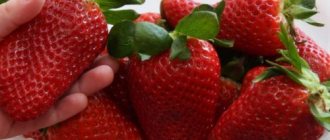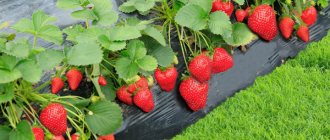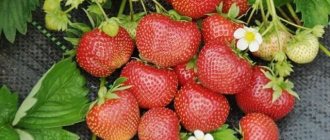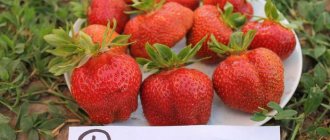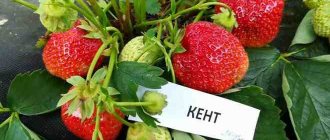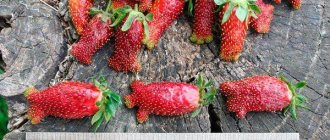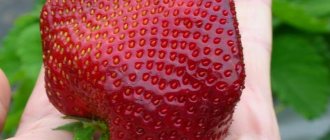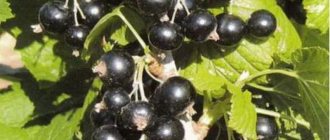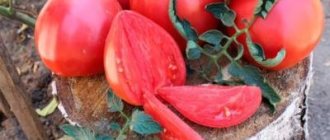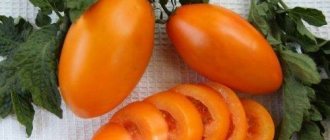Domestic gardeners did not remain indifferent to the success of Czech breeders - the Maryshka strawberry. This variety has earned a reputation as one of the most productive and tasty among large-fruited varieties of crops, well suited for cultivation on personal plots.
Strawberry Maryshka (pictured) is distinguished by the rapid ripening of large berries that have an original shape and a pronounced strawberry taste
In reviews, the variety is described as unpretentious and stable when cultivated in open ground in the central regions of Russia, as well as in Ukraine and Belarus, but is considered unsuitable for the harsh and moderate continental climate of Siberia and the Urals.
Information about “Maryshka” appeared on the Internet about 10 years ago. There is a possibility that in the Czech Republic itself the variety is called differently, so it is impossible to identify it by the Russian version of the name.
Description of the strawberry variety Maryshka
This crop grows in the form of small bushes, with a small number of large, dark green, glossy leaves. They are located close to the soil. Erect, strong peduncles grow on top of the leaves, which are capable of holding strawberry bunches containing up to 7 large, sweet berries.
In contrast to the compact above-ground part of the bush, the root system of the plant is branched, powerful, and lies deep in the soil.
Description of strawberries: they are large, oblong, pointed, dark red, juicy and sweet. The tasting rating is the highest. Large yellow seeds are located on the surface, which give the berries an appetizing presentation.
The weight of one fruit can reach up to 60 g. In one season, the Maryshka bush can bear up to 500 large, dense berries. The taste of the fruits is pleasant, sweet, with a strong aroma of wild strawberries; they are located in the upper part of the bush, on the leaves. The fruits always remain clean, and their arrangement makes harvesting much easier.
The description of the strawberry variety Maryshka can be supplemented with a photo showing its wonderful large berries.
Important! The fruits of the Maryshka variety remain large for many years and do not become smaller over time.
The Strawberry Monkey produces a small number of whiskers per season. This allows it to be propagated, but the variety does not need thinning.
Characteristics of the variety
Thanks to its branched root system, the Marishka strawberry is able to extract moisture and nutrients from the soil under unfavorable weather conditions. Prolonged drought and high temperatures in summer are not able to affect the fruiting of Maryshka.
Main advantages
The Czech variety is drought-resistant and can be grown even in the hottest regions. Under unfavorable weather conditions, the root system of strawberries wears out greatly. After harvesting, the bushes are generously filled with water. Applying fertilizers in autumn and spring before planting crops is necessary to obtain a good harvest.
The mouse grows and bears fruit on well-moistened, loose soils. For comfortable growth, allocate an area of at least 0.3 m2. A more frequent arrangement of bushes is fraught with the formation of rot.
The culture tolerates winters quite well. It is recommended to grow it in regions with a warm climate and mild winters.
Marishka berries are quite dry and dense. Thanks to this, strawberries retain their presentation for a long time and can be transported over any distance.
Flowering period, ripening time, yield
Maryshka strawberries are planted in September. After a successful winter, the first buds will appear at the end of April. In central Russia, the crop is classified as mid-early: the berries ripen in early June. In the southern regions, this variety is considered early: the fruits ripen in mid-early May. The harvest ripens quickly and evenly; you won’t be able to enjoy the berries for more than 2 weeks.
In 14 days of strawberry ripening, it can be harvested up to 0.5 kg per bush. This is approximately 3 kg of large fruits per 1 m2. Despite the fact that after 2 weeks the crop stops bearing fruit, gardeners have only positive reviews of the Maryshka strawberry.
Application area
Strawberry Maryshka is an excellent dessert variety with a high tasting score. Its berries are one of the first to appear after a long winter, so it’s nice to just enjoy them fresh. The fruits can also be frozen for the winter and used to make jam, confiture, and compote.
Resistance to diseases and pests
The strawberry variety Maryshka is resistant to the formation of gray rot - the main disease of plants of the Strawberry genus. In this case, the variety can be affected by red root rot. The disease affects tubers with a lack of sunlight.
Mites and aphids are the main pests of the Maryshka variety. They are also carriers of viral plant diseases. When the foliage turns yellow, harmful insects are destroyed first.
Advantages and disadvantages of the variety
The negative qualities of the variety include a tendency to be affected by red root rot and the impossibility of growing the crop in the northern regions.
Advantages of the Maryshki variety:
- large fruit;
- early ripening of fruits;
- unpretentiousness;
- ease of care;
- high taste qualities;
- disease resistance;
- drought resistance;
- winter hardiness.
Marishka berries ripen at the same time, which makes harvesting much easier.
Important! Tall peduncles are located above the leaves, this allows you to keep the berries whole and clean.
Reproduction methods
The strawberry variety Maryshka can be propagated using purchased seedlings, dividing the bush and breeding rosettes and mustaches. The latter method is more economical and less traumatic for the bush, since it does not require the purchase of seedlings or dividing the plant’s rhizomes into parts. The number of whiskers that appear on strawberries is sufficient for its reproduction.
They begin to root the culture in this way in early August. The whiskers are pulled out evenly in length and secured with metal brackets to the soil. As soon as 2 roots appear on the new branches, the seedling is separated from the mother bush and planted in a garden bed.
The photo shows how to propagate the strawberry variety Maryshka with a mustache.
Diseases and pests
The high yield of marmoset strawberries directly depends on the precautions that will be taken to prevent various diseases. What does this look like in practice?
It is recommended to inspect the bushes every day in order to notice the disease in time.
The most common disease of the “marine” variety is red root rot. It affects the plant due to excess moisture and lack of sunlight. To prevent damage, you can soak the seedlings in a weak solution of fungicides before planting. But how to recognize the disease on adult shoots?
Affected by rot, the strawberry roots turn black, and the leaves turn yellow and dry out. If you find alarming symptoms on a plant, remove the bush immediately.
Landing rules
Areas that were devoid of plants, especially nightshades, in the previous year are suitable for planting. They take all useful microelements from the soil, and strawberries can become infected with fungal diseases from them. Also, for planting, choose a well-lit area without drafts and excess moisture, with an acidity level of 5.5 to 6.5. Calcareous soils and saline soils should be avoided.
Important! Strawberry Maryshka seedlings are planted at the end of June, the mustaches are rooted in August.
For planting, purchase strong bushes with several healthy leaves without spots or damage. The root must be well formed and developed.
In the spring, before rooting the strawberries, the soil is carefully dug up and fertilizers are applied. You can mix 5 kg of humus with 1 tbsp. l. potassium fertilizer and 3 tbsp. l. superphosphate. This mixture is enough to fertilize 1 m2 of planting space. When planting in autumn, the area is dug up and only manure or humus is added to the soil.
Strawberry Maryshka seedlings can be planted in bushes and in rows. With the bush method, 2 or 3 plants are planted in one hole, with a space of half a meter between the holes.
If the crop is planted in rows, the distance between holes is 20-25 cm, between rows - 40 cm.
In summer cottages, I often plant strawberries using the carpet method (chaotically). With such planting, it is impossible to avoid the growth and crowding of bushes and a decrease in yield. Crop care for carpet planting is minimal.
Landing algorithm:
- Before rooting, dig holes 20 cm deep and add 1 tbsp. l. special fertilizers for strawberries.
- Afterwards, the seedlings are lowered into the hole, the roots are laid out evenly, straightened, being careful not to damage them.
- Afterwards, the plant is watered under the root with 1 liter of water.
- As soon as the liquid is absorbed, the roots are covered with fluffy soil so that the root collar is at ground level, and the soil is trampled down.
- Then the mustache and damaged leaves on the bush are cut off; they slow down the growth of the plant.
- After pruning, water the seedlings at the roots again, trying to prevent water from getting on the leaves.
At the last stage, the soil is mulched with sawdust or hay.
Video
We invite you to watch the presentation of the “Maryshka” variety and get advice from an experienced gardener on growing large-fruited strawberry varieties in the following videos:
About the author:
His main specialty is an accountant, so even at his dacha he strives for accuracy and achieving ideal order in everything. Preference is given to growing grapes. I am sure that the deeper you delve into gardening and gardening, the more you understand that there is no limit to perfection!
Found a mistake? Select the text with the mouse and click:
Ctrl + Enter
Do you know that:
It is believed that some vegetables and fruits (cucumbers, stem celery, all varieties of cabbage, peppers, apples) have “negative calorie content,” that is, more calories are consumed during digestion than they contain. In fact, only 10-20% of the calories received from food are consumed in the digestive process.
Aftercare
After planting, the strawberry Maryshka needs watering, subsequent mulching and fertilizing.
If the seedlings are planted in rows, they are watered between the rows; if using the bush method, they are watered at the root. Watering is carried out regularly once a week, if there is no rain. No more than 1 liter of water is poured under one bush before harvesting, so as not to provoke the appearance of rot. After harvesting, strawberries are watered abundantly.
Mineral and organic fertilizers are used as strawberry fertilizers. If there is an excess of them, you can get thick, lush greens and a weak harvest. If the soil was fertilized before planting, the first year's strawberries are not fertilized. The next year after planting, the bushes are watered with a solution of bird droppings or mineral fertilizers in accordance with the instructions. Fertilizing is applied during the flowering period, during the formation of ovaries, and in the fall after harvesting.
Strawberry Maryshka grows well in loose soils. Regularly after watering, the soil should be loosened or dug shallowly, then covered with a thin layer of hay and sawdust.
Preparing for winter
After harvesting, Maryshka strawberries are watered abundantly once a week until the weather gets colder. Then humus is added to the soil at the rate of 3-5 kg per 1 m2. With the onset of cold weather, especially in the central regions, strawberry bushes are covered with film. As soon as the first snow falls, you can throw it on the film cover. It will serve as winter insulation.
The nuances of growing berries
To achieve results when growing berries, you need to put in a lot of effort, although agricultural technology does not differ from the rules for growing any variety.
Boarding time
The best time for planting young bushes is considered to be the end of August. From August until the onset of severe frosts there is still a lot of time during which the plant will take root and grow its root system well. Next year the strawberries will produce their first harvest.
Selection and preparation of a site
Choosing a site for strawberries is an important step in cultivation. Lighting, wintering, soil moisture depend on it:
- If there are slopes in the garden, then it is better to place the bed at the top. A lot of moisture accumulates below, which has a detrimental effect on the roots of Marmalade. In addition, there is not enough light in the lowlands. But there is still an advantage: in winter there is a lot of snow there; even in a winter with little snow, the berry fields do not have to be covered.
- Strawberries love space. If it is deficient, the lateral shoots, if not pruned, will thicken the queen cell. Select a site with neutral or slightly acidic soils.
Strawberries of the Marmelada variety are planted in an open area where there is sufficient lighting and there are no trees or shrubs nearby. It should not be placed near potatoes, eggplants and tomatoes, as viral diseases from vegetable crops can spread to the berry garden. And also, if there is little snow in winter, the plantings can be covered or objects for snow retention can be placed.
Preparation of planting material
Planting material can be purchased, or you can grow it on your own plot if you have several pure-quality seedlings. You need to buy them only from trusted distributors or gardeners and nurseries.
Young Marmalade strawberry bushes must be carefully selected:
- They should not have dry roots or leaves.
- The leaves are bright green with pubescence that looks like a silvery coating.
- The middle bud should be thickened.
- The bush is low, not elongated due to lack of sun.
- It is better to buy seedlings in containers; their root system is not damaged and will quickly take root.
- Mustache sections should be visible, approximately 4 cm.
If strawberry seedlings are grown independently, then caring for them is similar to caring for the mother plant. As the tendril and daughter rosettes on it develop, they are sprinkled with earth. This happens at the beginning of summer. And at the end of August they can be cut off, dug up and transplanted to the main bed.
Planting scheme
The planting scheme for varietal strawberries is simple. Leave about 30 cm between adjacent bushes, more is possible, and leave 20 cm between rows. If a queen plant is planted, then it is better to increase the distance so that there is room for digging in side rosettes.
